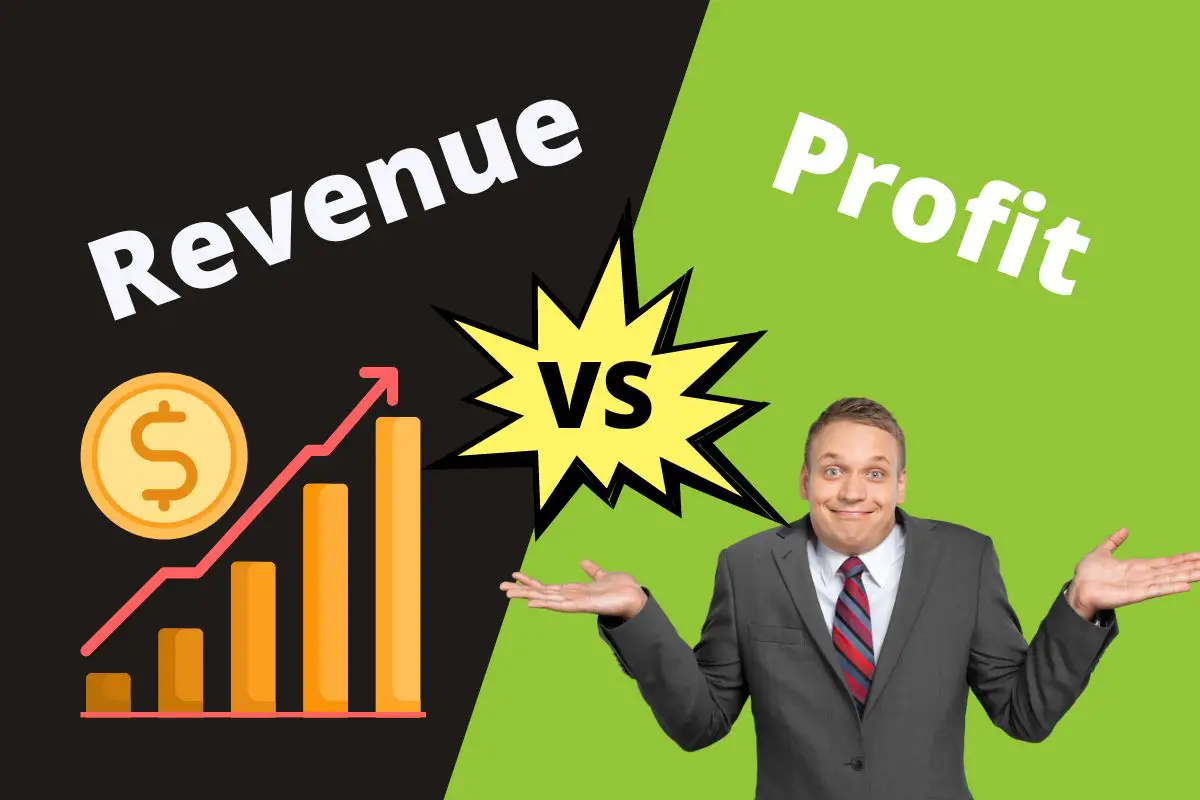Revenue is the total amount of money your business makes through product or service sales. It is the earnings before interest and taxes are paid. Profit is the amount that remains after paying salaries, debts, taxes, and other expenses required to run the business.
Starting your own business requires you to understand a lot of financial terms. Revenue and profit are the two most common yet essential concepts every earning person should know. Whether you’re launching a start-up or working in a corporation, you should know how revenue differs from profit.
Table of Contents
Difference Between Revenue and Profit
| Revenue | vs | Profit |
| Revenue is the total income without deducting any expenses | Definition | Profit is the final or remaining income after deducting all the expenses |
| Top line, gross sale | Other names | Bottom line, net income |
| Operating revenue Non-operating revenue |
Types | Net profit Gross profit Operating profit |
| Total sales x price per product = revenue | Formula of calculation | Revenue – all expenses = profit |
| The more revenue a business generates, the better its chances of increasing your profit | Effect on your income | Profit margin helps you analyze the performance of your business |
| Appears on the trading account | Position on financial statement | Appears on the income statement and is transferred to the balance sheet |
| Generating maximum revenue is crucial for operating a business | Importance | Generating more profit is essential for the growth of a business |
| Revenue is generally written on top of the income statement | Where to find | Profit is usually written at the bottom of the income statement |
What is Revenue?
Revenue or gross sale is your business’s total income by selling your services or product over a determined period of time (often annual). Revenue is also called the top line because it is the amount of money that sits at the top of your income statement before deducting any expenses.
Revenue Example
You have a food stall and make $10,000 a year. This is your gross revenue after selling your product (food). Still, you have not excluded your expenses while selling your product.
This $20,000 also includes the money you spent buying the products, salaries you paid to your co-workers, and other expenses.

What is Profit?
Profit is the remaining amount after clearing all the expenses. Profit is also called the bottom line because it remains at the bottom of your financial statement. Profit or net income also analyzes the performance of your business.
There are profit margins between your revenue and net profit.
Gross profit is the sum you get after subtracting the cost of goods sold (COGS). It means excluding the money you spend to manufacture the goods/ service your company sells.
But operating profit is the amount you get after subtracting other expenses like utilities, rent, EMIs, payroll, etc.
Profit Example
Suppose you spend $3000 on buying the raw materials or ingredients for the food you sell. Now you are left with $17,000, which is your gross profit.
You spend another $3000 operating expenses like rent, EMIs, etc. The final amount you are left with is $14,000, your operating profit.

Revenue vs Profit: Key Differences
Types of Revenue
- Operating revenue: The amount of money a business owner generates through the company’s principal business activities. For example, if you’re a retailer, your operating revenue will come from selling your primary product.
- Non-operating revenue: Non-operating revenue is the sum you earn from other sources that are not part of your primary business. Non-revenue income is irregular and non-static. For example, a wellness company also provides consultation, which would be the company’s non-operating income.
Types of Profit
- Net profit: Net profit or net income is your business’s profit after deducting the cost of goods sold.
- Gross profit: Gross profit is the sum you are left with after deducting the total expenses of material and labor costs.
- Operating profit: Operating profit is the amount you make before removing interests and taxes.
Effect on Business
The company’s revenue may cover all the operating expenses, but it may not leave any gross profit margin. Net revenue is to pay dues, payrolls, income tax, and other related expenses. You may not get to keep a profit margin from the revenue. Also, to expand businesses, businesses always try to maximize their revenue.
Net profit always helps you analyze how your business or startup is performing. If you manage a huge profit margin, you can invest it in expanding your company even more.
Formula of Calculation for Revenue
Multiply the number of items you sold by the selling amount.
For example, if you sold 1200 tacos for $10 each. Your revenue would be $12000, since 1200 tacos x $10 = $12,000.
Formula of Calculation for Profit
Take the total revenue and subtract the total expenses (interests, taxes, operating costs, and other expenses) from it.
For example, if your revenue was $12,000 and your total expenses were $5,000, your profit would be $7,000.
Hopefully, this article has answered all your queries related to revenue and profit. The performance of the revenue will affect the growth of net profit. This is why your goal should always be to maximize your revenue.
If you’ve enjoyed this article, check out our post on LTE vs 5G.

